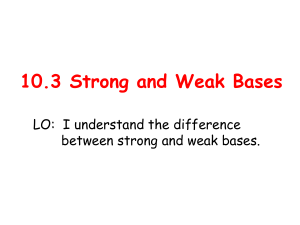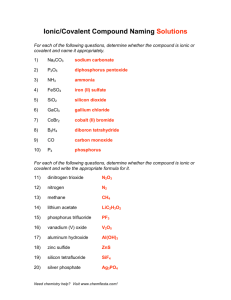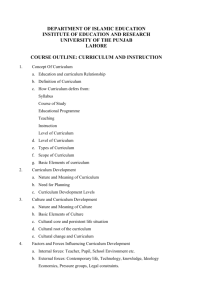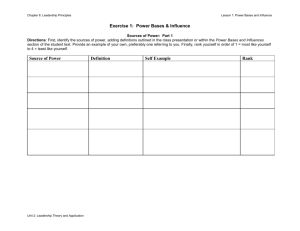Topic: Molecular Compounds
advertisement
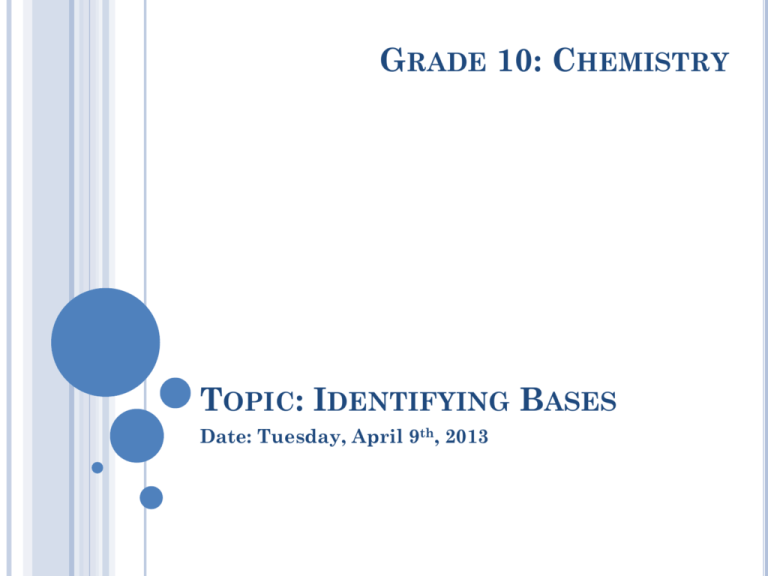
GRADE 10: CHEMISTRY TOPIC: IDENTIFYING BASES Date: Tuesday, April 9th, 2013 PUZZLERS Created by: Mr. Luoma ELEMENT OF THE DAY ELEMENT OF THE DAY What element was used in trench warfare during WWI? ELEMENT OF THE DAY: CHLORINE Atomic Number: 17 17 Protons, 17 Electron Atomic Weight: 35.45 Location: Group 17 Diatomic (Cl2) Forms many compounds NaCl (table salt) ELEMENT OF THE DAY: CHLORINE Why is Chlorine cool to learn about? Chlorine has saved more lives than it has taken Cheapest, most effective, and least harmful disinfectant Found in common household chemicals (bleach) Used to treat drinking and wastewater Used to prevent bacteria and algae in swimming pools No long-lasting environmental effects Main component of stomach acid (HCl hydrochloric acid) ELEMENT OF THE DAY: CHLORINE Properties of Chlorine Stop at 5:03 http://www.youtube.com/watch?v=BXCfBl4rmh0&NR =1&feature=fvwp Identifying Bases (Page 225) Bases are compounds that form hydroxide ions OH-(aq) when dissolved in water. Bases can also be described in the following ways: • Bases have a bitter taste. • Bases are slippery to the touch. • Bases can give serious chemical burns. They are corrosive to skin. Copyright © 2010 McGraw-Hill Ryerson Ltd. IDENTIFYING BASES Teacher Interactive CD ‘Identifying Bases’ Video Identifying Bases (Page 225) As with acids, there are two definitions for bases. The Arrhenius definition considers a base to be a substance that dissociates in water to produce OH-. The Brønsted base is defined more broadly as a proton acceptor. As with the definition for a Brønsted Acid, the Brønsted base is not required to be in solution. NaOH is found in plumbing products, while NaHCO3 is the key ingredient in baking soda. Blank this out Copyright © 2010 McGraw-Hill Ryerson Ltd. Naming Bases (Page 226) Since many bases are ionic compounds, they follow the same naming rules. Some bases have common names often found on consumer products. The rules for naming bases are: 1. The first part of the name is that of the positive ion (cation), the name of the metal. 2. The second part of the name always identifies the negative ion (anion), the name of the non-metal. The name of the nonmetal ion always ends with the suffix -ide. Copyright © 2010 McGraw-Hill Ryerson Ltd. Naming Bases: Formulas, Names , and Uses (Page 226) Copyright © 2010 McGraw-Hill Ryerson Ltd. Sodium Hydroxide in Industry (Page 226) As illustrated by the diagram below, sodium hydroxide (NaOH) is one of the most important chemicals in industry. The majority of sodium hydroxide is produced by the chlor-alkali process. 2NaCl(aq) + 2H2O (l) 2NaOH(aq) + Cl2(g)+ H2(g) Copyright © 2010 McGraw-Hill Ryerson Ltd. Writing Chemical Formulas for Bases (Page 227) The following steps should be followed when writing base formulas. 1. Use the periodic table and/or table of polyatomic ions to identify the symbols for the cation and anion in the base and their charges. 2. Add subscripts to balance the charges. Copyright © 2010 McGraw-Hill Ryerson Ltd. WRITING NAME & FORMULA FOR BASES Work on the sheet handed out. We will take it up when people are finished. Be ready to provide the answers. If you complete the front side, try to do the other questions on the back Naming and formula writing for both acids and bases LITERACY TEST PREPARATION Page 261 in Textbook Multiple Choice 29. b. 30. d. 31. a. 32. a. 33. c. Written Answer 34. Example: Magnesium is important to daily life, playing a role in a number of important processes from body processes to transportation. SUPPORTING DOCUMENTS ON Science 10 Textbook Pages: 225 - 228 HOMEWORK ON Science 10 Textbook Pg. 227 #1-2 Pg. 228 #1-8 HOMEWORK ANSWERS Pg. 228 1. hydrogen ion and anion of the non-metal 2. Example: HOMEWORK ANSWERS Pg. 228 3. an acid 4. produce hydroxide ions when dissolved in water, taste bitter or feel slippery 5. a. calcium hydroxide b. phosphorous acid c. hydrogen fluoride d. potassium hydroxide HOMEWORK ANSWERS Pg. 228 6. a. H3PO4 b. HBr c. Mg(OH)2 d. Al(OH)3 7. a. HClO3(aq) → H+(aq) + ClO3–(aq), acid b. KOH(aq) → K+(aq) + OH–(aq), base HOMEWORK ANSWERS Pg. 228 8. Example: Group into either acid (HCl, H2SO4, and HClO3) or base (NaOH, Ca(OH)2, and LiOH), since each solution contains either a hydrogen ion or an oxide ion. NAMING & FORMULA WRITING FOR ACIDS & BASES WORKSHEET Formula Name Name Formula 1) NaOH sodium hydroxide 10) hydrofluoric acid HF 2) H2SO3 sulfurous acid 11) hydroselenic acid H2Se 3) H2S hydrosulfuric acid 12) carbonic acid H2CO3 4) H3PO4 phosphoric acid 13) lithium hydroxide LiOH 5) NH3 ammonia 14) nitrous acid HNO2 6) HCN hydrocyanic acid 7) Ca(OH)2 calcium hydroxide 8) Fe(OH)3 iron (III) hydroxide 9) H3P hydrophosphoric acid 15) cobalt (II) hydroxide Co(OH)2 16) sulfuric acid H2SO4 17) beryllium hydroxide Be(OH)2 18) hydrobromic acid HBr

